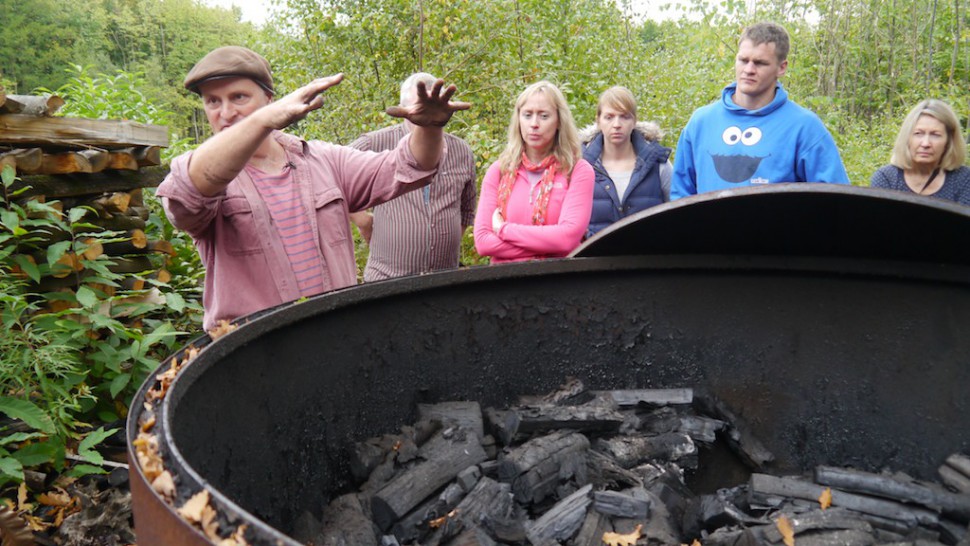Yesterday Peter and I spent the day in Prickly Nut Wood with Ben Laws, listening to him talk about his ‘forest life’ and his woodsmanship.
I almost always find being with people in a place that they are strongly connected to, moving. This was exceptional. It may have been life-changing.
Ben is extraordinarily connected with his woods. They have been his home and work for 22 years. He owns 8 acres (about 3 hectares) and manages another 90 acres (36.5 hectares). For the first eleven or so years he lived in a bender in the woods before deciding the use the timber of the woodland and his knowledge and skill in working it to create a house.
This project featured on what became the one of the most popular episodes of the ‘Grand Designs’ TV programme, which showed Ben designing, collecting timber for and building his house. A few years later, the television returned and showed him living happily in an extended house with a wife and baby. It was a a lovely story, about a beautiful building and a quiet man with vision and purpose.
Two or three times a year Ben opens his house and garden to a limited number of visitors. Yesterday we were two of those – in a flash of brilliance, our daughter had bought Peter, a manager and lifelong lover of woodlands, two places for his Christmas present.

It was a lovely day in mid autumn – a day of blue sky through the turning leaves, blackberries, and fungi. Ben lives in Sussex, a gentle , green, wooded and affluent county in south east England, far away (in every way) from the open moorland of Derbyshire where we live. His mixed woodlands are rich in sweet chestnut a strong, durable and workable timber that I could see Peter envied.
The woods are beautiful and varied. There are dense stands of well managed coppice, areas of regrowth that have been recently harvested and some fine oak standards. Being there with Ben added a dimension, maybe several dimensions, to the lovely place and my reasonable grasp of at least the fundamentals of woodland management. He has all the detailed knowledge, the practical experience, and the total familiarity with the wood and working it. He was a clear, articulate and welcoming host who encouraged all questions from his I guessed very mixed audience of foresters, architects, gardeners, tree surgeons, designers, permaculturalists.
Ben knew and acknowledged that people had come to see his house but insisted that we saw the wood, the source of his materials first. That was an excellent move. I learned so much more detail of how woods were traditionally managed to yield a range of valuable building products.
After lunch we visited his workshop, another early self build project where the basic structure was more visible and talked about the building techniques. By this time I think everyone in the room wanted to build their own roundwood timberframe house. I know I did.
Ben now has a business building and advising on such buildings throughout the country and a team of people working for him.
Then he showed his house. As he said, it was smaller than it looked on the telly. As one of the participants said, it is even more lovely. The group was quiet, almost reverential, possibly awestruck, looking at it. Ben, rather charmingly pointed out picky shortcomings that wouldn’t be like that if he was doing it now, while we stared around, open-mouthed.
I bet that at least one person in that group builds a house of sustainably sourced local timber within the next decade. I bet many of us will looking how we can live more sustainably and harmoniously with our surroundings. I suspect most will think harder about the sources of the timber products we buy and the life in the woodlands we pass through.
This wasn’t billed as a day to learn about sustainability or woodland management for wildlife. In fact, Ben probably communicated more of both than many days run by conservation organisations with those aims. He made sustainable living feel personal and highly desirable. Watch and learn.
There are many things we can gain from spending time in the woods.







